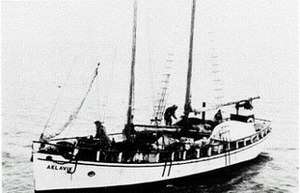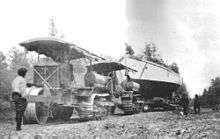Aklavik (HBC vessel)
Aklavik was a small cargo vessel the Hudson's Bay Company used to carry supplies, and furs, to and from its outposts in the high Arctic.[1] She was active in the first half of the 20th century.
 Aklavik, a Hudson's Bay Company cargo vessel, that may have made an unofficial transit of the Northwest Passage | |
| History | |
|---|---|
| Name: | Aklavik |
| Operator: | Hudson's Bay Company |
| General characteristics | |
| Length: | 60 ft (18 m) |
| Installed power: | 35 shp (26 kW) auxiliary engine |
| Capacity: | 45 tons |
Construction

She was 60 ft (18 m) long, had a cargo capacity of about 45 tons, and was mainly propelled by sail, although she had a 35-shaft-horsepower (26 kW) auxiliary engine.[1][2]
Aklavik was built in Vancouver, then shipped, by rail, to Fort McMurray, then the northernmost terminus of the North American railgrid. Up until the railgrid was extended to the riverport of Hay River, on Great Slave Lake, every vessel operating on, or transiting, the Mackenzie River, was shipped to Fort McMurray, then proceeded to a portage around the extensive rapids on the Slave River, near Fort Smith.[2] Aklavik was towed from Fort McMurray to the portage, without any engines. Used engines were installed after she transited the portage.
Operational history
She was frozen in, over-winter, in Bernard Harbour, in 1930, resulting in her sinking, but she was refloated.[2]
Some sources report that Aklavik was actually the second vessel to traverse the Northwest Passage, in 1937, under the command of Scotty Gall, not the Royal Canadian Mounted Police (RCMP) schooner St. Roch.[1]
According to the Hudson's Bay Company, however, since, after transiting the Bellot Strait, to Baffin Bay, she rendezvoused with a larger ship in the Company's fleet, Nascopie, transferred some cargo, and then turned around, stopping short of a full traverse of the passage.[3]
References
-
"E. J. (Scotty) Gall" (PDF). Arctic Profiles. p. 158. Retrieved 2017-04-29.
The Akluvik was 60 feet (20 metres) in length and drew 6 feet (2 metres) of water. It was powered by a 35 hp Fairbanks-Morse engine. While it was not a particularly good freighter, carrying only 40-45 tons of cargo, it was considered an excellent vessel for the Arctic. A few years after the 1937 trip, the Akluvik caught fire and sank off Cambridge Bay.
-
"Scotty Gall". Kitikmeot Heritage. Archived from the original on 2004-07-21. Retrieved 2017-04-29.
Scotty ended up in Fort Smith in May of 1923 helping to put an engine in the HBC schooner Aklavik.
-
"Our History: Transportation & Technology: R.M.S. Nascopie". HBC Heritage. Retrieved 2017-04-29.
Named after First Nations people of Quebec and Labrador, Nascopie was designed and built in England at Wallsend on Tyne in 1911.